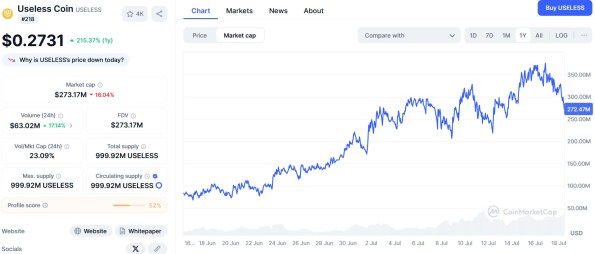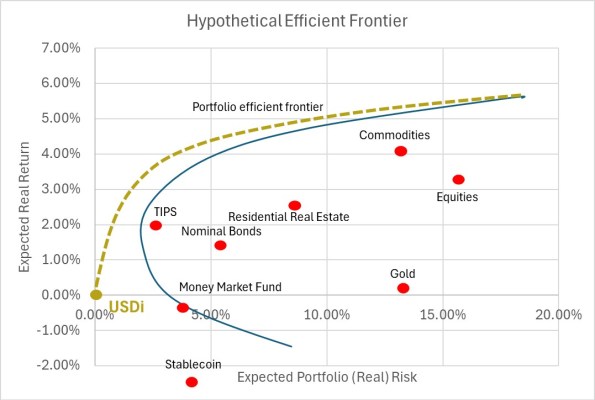It is rare, in the investment world, for an investment to honestly and fully disclaim its basic nature in a way that finishes the story and requires no further analysis from us before making an investment decision. I have found such an investment. It is a cryptocurrency/meme coin called, appropriately, . If you were to buy all of the USELESS in existence, it would cost you (as of this writing) about $272 million dollars. This seems to me to be a lot of money to pay for something useless, but what do I know?

Now, it should be noted that there are lots of useless coins. coin. Fartcoin. I could go on and on. But the difference here is that as far as I can tell, USELESS is being completely honest. It is not usable as a payment rail. It is not redeemable for anything, at any time, and therefore it is guaranteed to one day be worth zero. It doesn’t even come printed on a nice certificate so that the scripophiles can frame it and put it on the wall.
To be fair, as I said it isn’t the only such memecoin that is useless. It is merely the only one that turns that uselessness into a dare. It is a game, of seeing who eventually gets the ‘pride of place’ as top-ticking it, paying the highest price for something that is useless and that never pretended otherwise. (People who bought Enron stock were buying something that turned out to be worth zero, but they didn’t know it at the time. USELESS buyers are fully aware and cannot possibly claim otherwise.)
And actually, ironically, that unlocks the reason this coin exists. It reminds me of a fantasy baseball auction. For those of you who don’t play fantasy sports, there are generally two varieties: the ‘draft’ kind, where people take turns drafting players, and the ‘auction’ kind, where someone offers a player and a price they will pay for that player, from a limited budget allotment. The other participants in the draft all take turns bidding until someone wins the player, and then the process is repeated until every fantasy team is full. Done correctly, a bidder doesn’t merely bid for the players he or she wants but also bids up the price of a player he or she does not want, in order to force someone else to pay more than that player is worth. This part of the auction is a game, trying hard to make someone else pay top dollar – which requires you to figure out what everyone else’s top price is – while not getting stuck with the now-overvalued hot potato.
I think that’s what USELESS is. It’s a game of trying to push the price higher and higher, until someone is stuck with the honor of having paid the highest price for an utterly worthless unit. It’s a game; it’s only a game; and it is just as much of an “investment” as is the forty-two dollars you paid to select Juan Soto for your fantasy team.
Now, as you all know by now I have been at least partially converted and no longer think that all crypto is useless. The absolute opposite of USELESS is the enormous utility of our inflation-linked stablecoin, USDi. And yes, I’ve written about it before. And yes, I will write about it again. Because it’s as useful as it gets. There is no such thing as inflation-linked cash in traditional finance space. I am not aware of any bank that offers an inflation-linked savings account. And this is not a little thing. This is a big, big thing.
The chart below shows a hypothetical efficient frontier made up of a lot of different asset classes; this frontier might look a little different from what you’re familiar with because the x-axis and y-axis are in real terms whereas most of us learned finance in nominal terms where you had a Treasury bill as the risk-free asset. But we don’t care about nominal returns (if we did, we’d own stocks in the most hyper-inflating country we can find) – we care about real returns. In the nominal world, Tbills or money market funds exist with sub-zero real returns most of the time. More importantly, they have significant risk in after-inflation terms. As a result, in real space we are confined to the blue curve as our efficient frontier (the curve shows the lowest-risk portfolio that achieves a given expected real return. Remember these numbers are all hypothetical but the point I am making doesn’t depend on the numbers).

But USDi is, as I said, super useful. It is the origin security, the zero-real-risk, zero-real-return point. And that means that it improves every portfolio in real terms, with the possible exception of very-high-risk portfolios.
Now, most of these securities don’t yet exist in the defi world. There really aren’t any tokenized commodities yet, except in the narrow edge case of gold and one or two other single spot commodities – and no tokenized commodity indices yet, and commodity indices have additional sources of return beyond the spot commodity return. No tokenized TIPS, and few tokenized equities. Someday, the defi world will have these things. But what it does have right now, which is really useful and a good enough reason to visit the crypto world, is the low-risk security: USDi. How useful is that?
